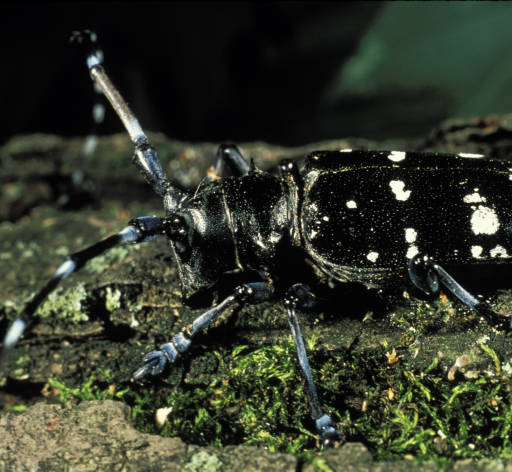The Asian longhorned beetle (Anoplophora glabripennis), also referred to as the starry sky beetle, is a large wood-boring insect native to eastern China, Japan, and Korea. It was first discovered in North America in 1996 infesting a bevy of trees in the Greenpoint section of Brooklyn, NY. It has since been reported in several other locations across the United States, as well as in Canada. Though it is innocuous to humans and animals, the Asian longhorned beetle is a destructive pest that is capable of decimating maples and other hardwood trees.
Hosts:
The Asian longhorned beetle infests a wide range of trees, but it is primarily attracted to maples. It affects numerous species, including boxelder, norway, red, sugar, and silver maple. It has also been reported infesting a number of other trees, including birch, elm, horsechestnut, ohio buckeye, and willow. In a few rare instances, it has been discovered in mountain ash, london planetree, poplar, and mimosa.
Appearance:
The Asian longhorned beetle is a large insect that ranges from one to two inches in length. It has a shiny, black torso, and a broad, cylindrical frame with a pair of black wings that are dotted with white spots. Three pairs of legs extend out from its body, connecting to a series of metallic looking blue feet that enable it to cling to the surface of trees with ease. The upper section of each leg is a whitish-blue color. A pair of long antennae protrude out from its head, each banded with a distinct white and black pattern. This pattern helps distinguish the Asian longhorned beetle from other species that share similar traits. Females tend to be larger than males, and have shorter antennae. Larvae are smaller in stature, but still have a relatively broad build. They are paler in color, with a white or yellow tinge.
Life Cycle:
The Asian longhorned beetle reproduces throughout the summer and early fall. After mating, females select a host tree, and create up to ninety oval depressions in the tree’s bark; these depressions are referred to as oviposition sites. This can result in weeping sap, which is seen flowing out from the wound created at each depression. Females lay a single small egg beneath the bark of each site, and leave them to develop until they are ready to hatch. Eggs require warmth to develop, and will remain dormant unless temperatures exceed 50 °F. If conditions are ideal, eggs can hatch within ten to fifteen days. If temperatures fluctuate, or remain below 50 °F for an extended period of time, they can take up to sixty days to hatch. If the eggs require additional time to develop, they will go dormant over the winter, and hatch the following spring.
Once the egg hatches, the emerging larvae tunnel deep into the phloem and cambium of the tree, navigating their way to the tree’s inner woody tissue. The larvae then feed on the live tissue, using it to sustain themselves as they continue to develop through their five instars. After several months, the larvae burrow deeper into the tree’s heartwood, creating fresh tunnels, and producing a sawdust-like material called frass that they push out of the tree. Once they have become settled, they continue feeding on the live tissue throughout the winter months, gradually sapping the tree of its nutrients, and consuming its water supply.
After completing their final instar, the larvae pupate during the spring, and enter a transitional state called eclosion. Once eclosion has ended, they emerge as adults, chewing their way out of the tree a week later. They begin to emerge in late May, creating a large exit hole in the tree that is a quarter inch or greater in size. They continue to appear through October, with their peak emergence occuring in July.
Impact on Trees:
As the larvae burrow into the tree, they create a series of tunnels that produce a girdling effect on the tree’s stems and branches. This effectively kills live growth, causing the affected branches to wilt and die. Larvae also feed on vital nutrients that trees require to grow. As the larvae feed, the tree gradually loses its nutrient supply, causing it to wither, and eventually fail.
Detection & Management:
Trees should be thoroughly inspected by a professional arborist at least once a month during the summer and early fall. This is when the Asian longhorned beetle is most active. If a tree is determined to have been infested, it should be promptly removed in order to prevent the insect from being spread to other trees. Once the tree has been removed, the remaining woody materials should be properly disposed of.
